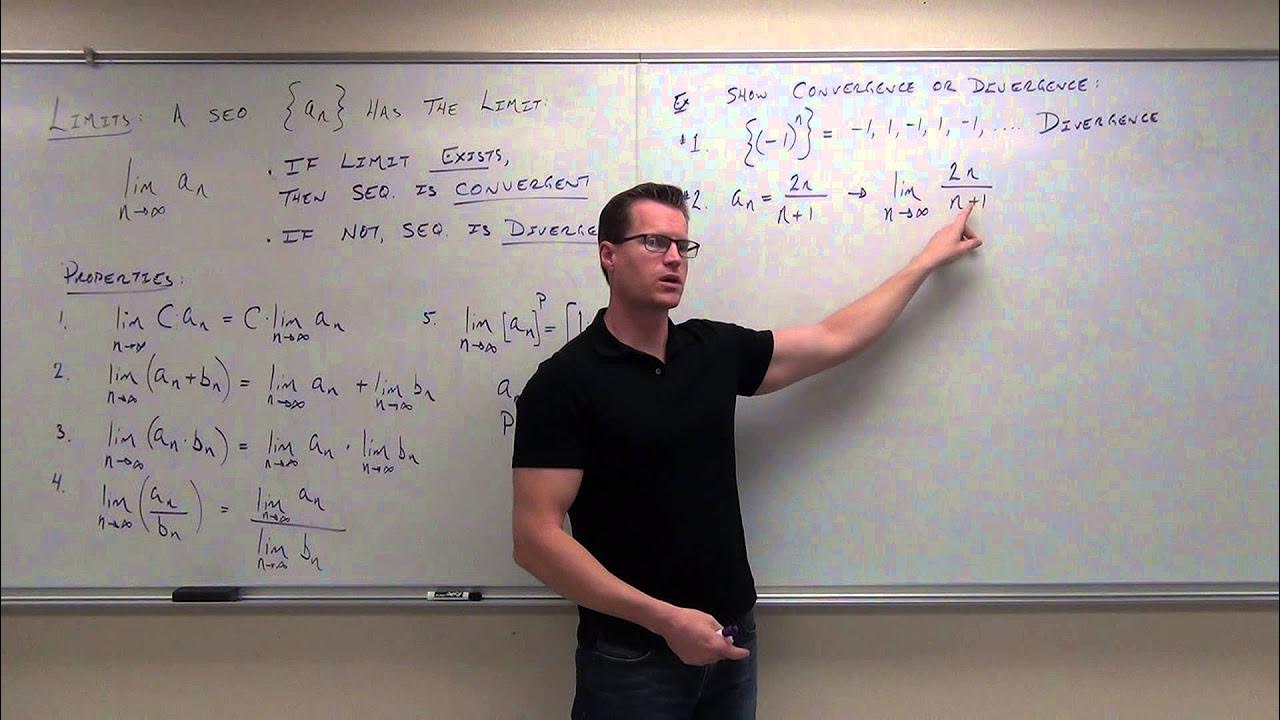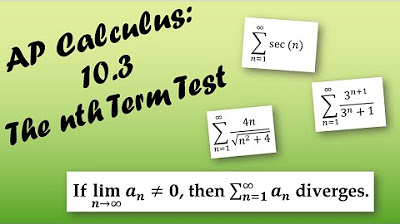Calculus Nth Term Test
TLDRIn this educational video, the instructor delves into the concepts of sequences and series, focusing on their convergence or divergence. They define a sequence as an ordered list and a series as the summation of a sequence. The video emphasizes the importance of the limit for determining convergence, introducing the nth term test for divergence. The instructor provides several examples to illustrate these concepts, including series with factorials, and cautions that the nth term test cannot confirm convergence, only divergence. The session encourages students to explore series further with calculators and anticipates a follow-up video for deeper exploration.
Takeaways
- 📚 The lecture begins with an introduction to Chapter 9, focusing on sequences and series, specifically sections 9.1 and 9.2.
- 🔍 A sequence is defined as an ordered list of terms, often denoted as \( a_n \), where 'n' represents the position in the sequence.
- 🌟 The convergence of a sequence is determined by whether it has a limit, \( L \), as \( n \) approaches infinity.
- 💥 A series is the summation of a sequence, and it diverges if the sum approaches infinity; otherwise, it converges if the sum remains finite.
- 🤔 The chapter's main questions are to determine if a series converges or diverges, and if it converges, to what value.
- 🌌 An example given is the series \( \sum_{1}^{\infty} 2n \), which clearly diverges as it approaches infinity.
- 📉 Another example is the series \( \sum_{1}^{\infty} \frac{1}{n(n+1)} \), which converges as the sequence approaches a limit of 1/2.
- 🚫 The nth term test for divergence states that if the limit of \( a_n \) as \( n \) approaches infinity does not equal zero, the series diverges.
- ⚠️ The nth term test cannot be used to prove convergence; it only indicates divergence if the limit is non-zero.
- 📝 The instructor encourages students to use calculators to explore series and observe the behavior of partial sums.
- 📅 A follow-up video is planned for the weekend, with a continuation of the topic on Monday.
Q & A
What is the main topic discussed in Chapter 9 of the book?
-The main topic discussed in Chapter 9 is sequences and series, specifically focusing on the term test.
How does the instructor define a sequence?
-A sequence is defined as a list of things where order matters, usually denoted as a_sub_N, where N represents the position in the sequence.
What is the condition for a sequence to converge?
-A sequence converges if it has a limit as N approaches infinity, meaning a_sub_N settles down to a limit L.
How is a series defined in the context of sequences?
-A series is defined as a summation of a sequence, starting at a specific point, usually at one, and continues adding the terms of the sequence.
What does it mean for a series to diverge?
-A series diverges if the summation of its terms approaches infinity or does not stay finite.
What are the two main questions addressed in the chapter about series?
-The two main questions are: 1) Does a series converge or diverge? 2) If it converges, to what value does it converge?
What is the 'nth term test for divergence'?
-The nth term test for divergence states that if the limit of the sequence (a_sub_N) as N approaches infinity does not equal zero, then the series diverges.
Can the nth term test be used to prove convergence?
-No, the nth term test can only be used to prove divergence, not convergence.
What is an example of a series that diverges?
-An example of a diverging series is the summation from 1 to infinity of 2, which results in the sequence 2 + 4 + 6 + 8 + ... and diverges to infinity.
What happens to a series where the limit of the sequence as N approaches infinity is zero?
-If the limit of the sequence as N approaches infinity is zero, the nth term test says nothing about whether the series converges; other tests are needed to determine convergence.
Outlines
📚 Introduction to Sequences and Series
The video begins with an introduction to Chapter 9, focusing on sequences and series. A sequence is defined as an ordered list of terms, often denoted as \( a_n \), and is said to converge if it has a limit as \( n \) approaches infinity. Conversely, a sequence diverges if it does not have a limit or if the limit is infinity. A series is the summation of a sequence, and it converges if the sum remains finite as \( n \) approaches infinity, otherwise, it diverges. The chapter will address two main questions: whether a series converges or diverges and, if so, to what value. The instructor provides an example of a series that clearly diverges, the sum of even numbers from 2 to infinity.
🔍 The nth Term Test for Divergence
This paragraph delves into the nth term test for divergence, a method to determine if a series diverges by examining the limit of its sequence as \( n \) approaches infinity. If the limit is not zero, the series is guaranteed to diverge. The instructor illustrates this with examples, including a series where the terms are \( \frac{1}{n} \), which converges because the limit of the sequence is zero, and another where the terms are \( \frac{n}{3^n} \), which diverges because the limit is not zero. The instructor also emphasizes that the nth term test cannot be used to prove convergence, only divergence.
⚠️ Caution on Using the nth Term Test
The final paragraph serves as a cautionary note about the limitations of the nth term test. It is a test strictly for divergence and should not be misconstrued as evidence for convergence. The instructor encourages students to experiment with series using calculators to observe the behavior of partial sums and to look forward to another video that will be released over the weekend. The session concludes with a reminder of the upcoming Monday's class.
Mindmap
Keywords
💡Sequence
💡Convergence
💡Divergence
💡Limit
💡Series
💡Partial Sum
💡nth Term Test for Divergence
💡Factorial
💡Homework Assignment
💡Calculator
Highlights
Introduction to Chapter 9 focusing on sequences and series.
Definition of a sequence as an ordered list where order matters, denoted by sub N.
Explanation of sequence convergence based on having a limit as n approaches infinity.
Sequence divergence occurs if it does not have a limit or if the limit is infinity.
Definition of a series as the summation of a sequence, often starting at one.
Series convergence is determined by the summation staying finite as n approaches infinity.
The two main questions of the chapter: Does the series converge, and if so, to what value?
Example of a divergent series: the sum of 2 plus 4 plus 6 to infinity.
Illustration of the nth term test for divergence using the series 1/n.
The nth term test indicates divergence if the limit as n approaches infinity does not equal zero.
The nth term test cannot be used to argue for convergence, only divergence.
Example of a series that does not converge using the nth term test: 1/(3n).
Example of a series that diverges using the nth term test: n/(3n).
Discussion on factorials and their behavior in series convergence tests.
Final example involving factorials and the nth term test for divergence.
Encouragement to use calculators to explore series behavior and partial sums.
Announcement of a follow-up video to further discuss series.
Transcripts
Browse More Related Video
5.0 / 5 (0 votes)
Thanks for rating:





